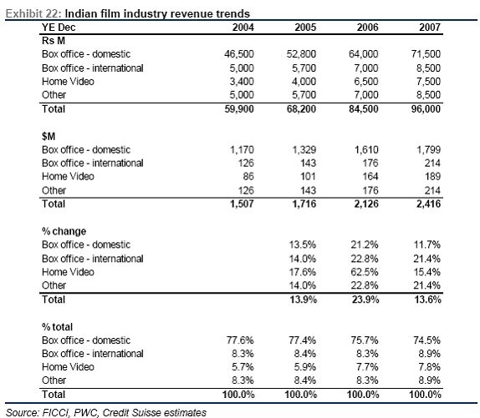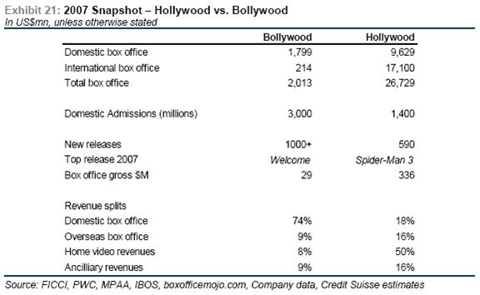Bollywood Coming of Age
The Indian film industry, commonly referred to as “Bollywood”, has received much attention in past few weeks with reports of Steven Spielberg’s potential deal with India’s Reliance Entertainment for a substantial equity infusion allowing him and his Dreamworks partners to break away from their current ownership structure at Paramount Pictures (VIA). Additional reports this past week also have Sylvester Stallone starring in his first Bollywood picture with Indian star, Akshay Kumar. However, Bollywood is no overnight sensation despite the mainstream U.S. media’s recent attention to it, and upon closer examination one can see there is far more depth to these moves than meets the eye.
The chart below, taken from a recent Credit Suisse report entitled “Challenges for Hollywood in Bollywood”, shows just how far the industry has come in recent years:
click to enlarge images
While the overall numbers involved pale in comparison to the traditional Hollywood film community, the growth levels are extremely robust. Credit Suisse reports that much of the growth is due to ramped up distribution platforms, dramatic increases in ticket pricing, and recent access to international marketplaces:
While domestic box office remains hostage to individual creative success, box office revenues are benefiting from the rollout of multiplexes, which on average lift ticket costs from $1 to $4 compared with a single theatre. The rollout of digital screens is also proceeding rapidly. International box office has been growing more rapidly than domestic, as distributors focus on the opportunity presented by the Indian diaspora.
Reliance Entertainment has acquired over 200 cinemas in 28 North American cities over the past 12 months. Home video revenue remains very small in India relative to the shares achieved in the US. However, growth is outperforming domestic box office as DVD penetration has increased from 3% to 11% of TV households. Ancillary revenue growth is also outperforming the domestic box office, reflecting strong demand from television as well as merchandising growth.
If published reports turn out to be true, recent efforts by Reliance to woo the Dreamworks team could be less of a mandate to expand Bollywood’s presence in the U.S. then it is an effort to secure high quality proprietary content for the emerging distribution platforms they are aggregating worldwide.
Overall though, the comparison is quite interesting when viewed side by side. Each has unique characteristics that complement the other, and though Hollywood remains the dominant revenue winner, Bollywood is churning out films and audiences at rates close to double its American counterpart.
Clearly, where Hollywood could be most vulnerable is in the international marketplace where it has grown so dependent and towards which Bollywood has barely scratched the surface. This may explain Bollywood’s desire for a big-name, international superstar like Stallone to lend his name to a project, even if only in a cameo role. This presence of more internationally recognized stars combined with a robust distribution platform could give Bollywood a distinct leg-up in the world marketplace in the coming decade. At a minimum, the sector should be extremely interesting to watch if it continues on the growth trajectory that has been building over the past few years.


Comments
How're you macha?